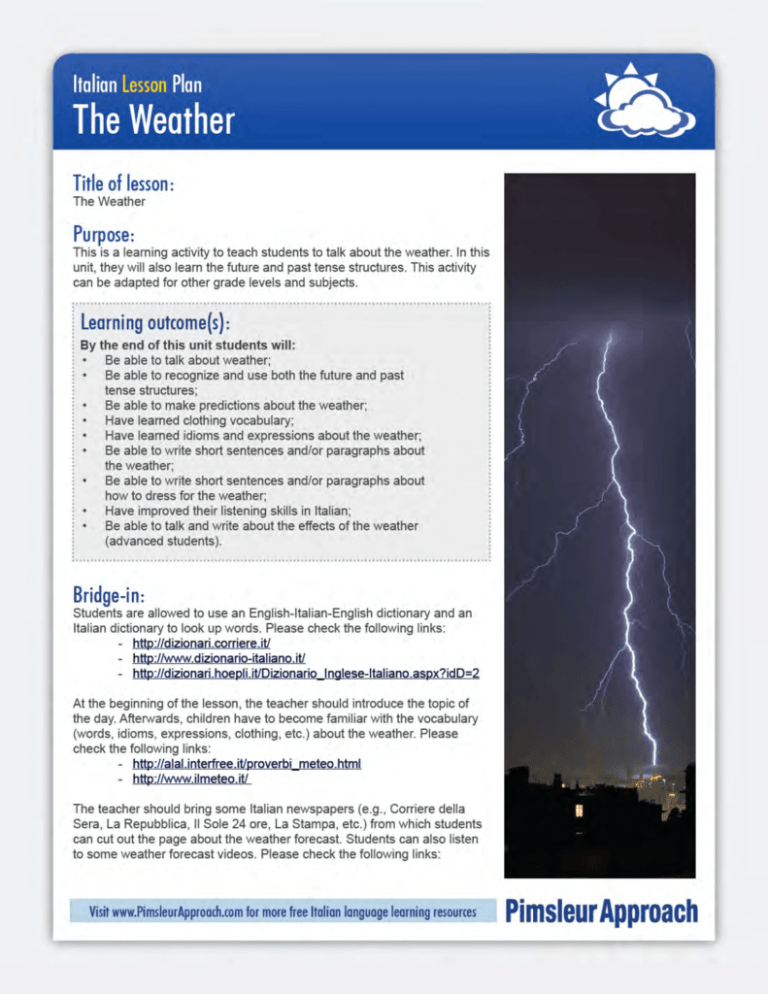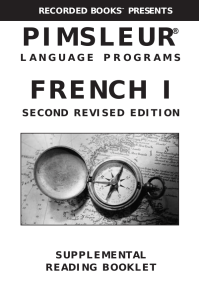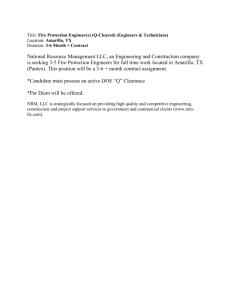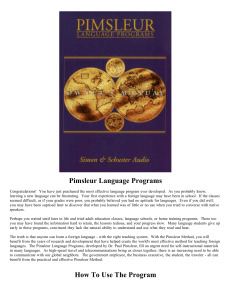
Italian Lesson Plan
The Weather
- http://www.rai.tv/dl/RaiTV/programmi/media/
ContentItem-edb9b35a-3dd2-4611-99db656254eb64b8-tg1.html
- http://www.youtube.com/watch?v=Jp51vgck 6I
- http://www.youtube.com/watch?v=Ei0HwKYIbFk
&feature=related
Pre-Test:
Before continuing with the learning activities, the
teacher should be sure students have learned the
vocabulary about the weather (sole, soleggiato,
nuvoloso, uggioso, piovoso, foschia, pioggia, nebbia,
etc.). Prepare a simple vocabulary quiz or some
questions-answers exercise.
Input from teacher:
1. Students have to read, underline, and look up in the
dictionary the words and expressions they found in the
weather forecast section of a newspaper.
2. To learn the clothing vocabulary, students can cut
out some clothing images from fashion magazines and
create flashcards. On one side of the flashcard they
write the name in Italian and on the other side they stick
the image. When they know the words, they can create
memory cards to continue practicing the words and
expressions.
3. When students are familiar with the vocabulary,
the teacher should teach the future and past tense
structures.
4. Students should keep a weather journal in Italian,
describing the weather and how they get dressed, for a
week up to a month, depending on the student’s age and on
their ability to learn.
5. In class, the teacher should divide students in groups.
Each group should forecast the weather for the whole
following week. When they finish, each group has to
present in front of the class what they have forecast.
6. In class, students should write sentences about how
to dress for the weather. This is an exercise that will help
students doing their homework (keep a weather journal in
Italian).
7. Older and advanced students should write stories/
texts about the effects of the weather, both climatic and
geographical changes. To help them with the vocabulary
check the following links:
- http://www.youtube.com/watch?v=V1r4nFUVJM8
- http://europa.eu/legislation summaries/environment/
tackling_climate_change/index_it.htm
- http://www.ecoblog.it/post/11940/i-5-segnidei-cambiamenti-climatici
Closure:
At the end of the lesson, some students should recap
what has been taught during the lesson and in their
homework. Students should also say whether they had
problems in understanding and learning the lesson;
in this way the teacher can help them to solve these
problems and he can also find a different way to teach
them this topic.
Check for Understanding:
Use flashcards and memory cards, prepare a
vocabulary test, ask students questions about a video or
an audio file they listened to.
Assessment:
Students should continue practicing this lesson in order
not to forget what they have learned.
It is up to the teacher to choose the best way to
assess students: oral or written exam, multiple choice
exam, reading and comprehension, listening and
comprehension, etc.
© 2012 Stroll LLC. All rights reserved.
Copyright © 2000-2012 Internet Order, LLC. All rights reserved. “Stroll” and “Internet Order” are trademarks of Internet Order, LLC.
Internet Order, LLC sells Pimsleur® products but is not an affiliate of Simon & Schuster, Inc. (the publisher of Pimsleur® products)
or of Beverly Pimsleur (the owner of the Pimsleur® trademark, which is licensed exclusively to Simon & Schuster). Any use of the
Pimsleur® name or associated marks is solely to identify the products sold by Internet Order, LLC. Internet Order, LLC is solely
responsible for the contents of this document.
Visit www.PimsleurApproach.com for more free Italian language learning resources


![Your_Solutions_LLC_-_New_Business3[1]](http://s2.studylib.net/store/data/005544494_1-444a738d95c4d66d28ef7ef4e25c86f0-300x300.png)




